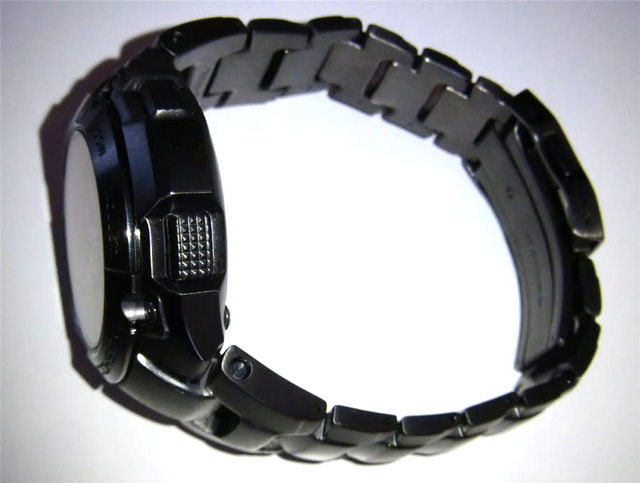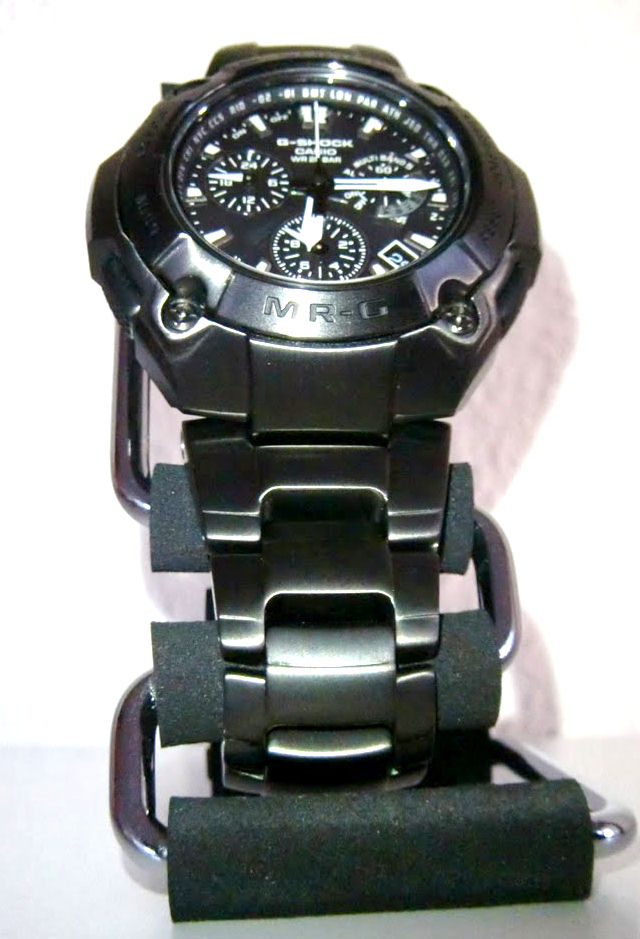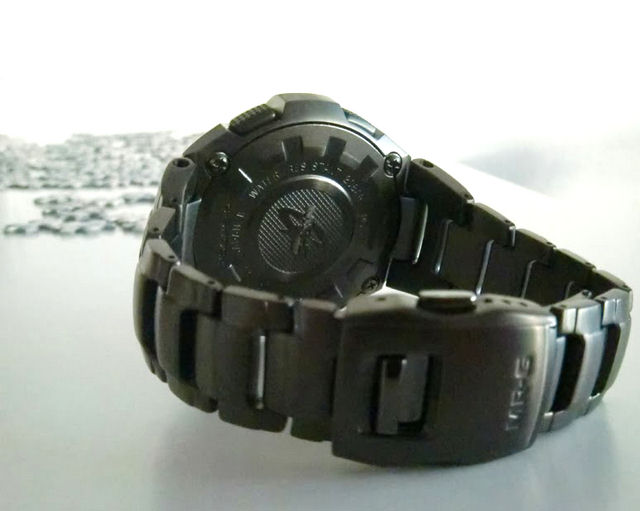Posted the 13th day of October in 2010 by Riley.
| Tweet |
Original post written by John Harrison. This review was edited by Riley with the permission of the author.
The MRG-7500BJ-1AJF is a chronograph G-Shock model first released by Casio in 2007. The DLC titanium case and bracelet look great. And it packs in some nice features like 5 band atomic sync. This watch has only been officially for sale in Japan, and it has a street price of around $1,700 USD.
 |
Specifications:
- Shock resistant construction
- Titanium case and bracelet with DLC coating
- Sapphire crystal
- Perpetual calendar
- Tough solar charging
- Water resistant up to 200M
- Atomic clock signal reception (maximum of 6 times/day) + manual reception
- Japan: JJY on 40kHz/60kHz
- North America: WWVB on 60kHz
- Europe: MSF/DCF77 on 60kHz/77.5kHz
- ±20 seconds a month at non-atomic reception
- World time: 27 cities (29 time zones) time indication and daylight-saving time setting
- Chronograph (1/20 seconds, 60 minutes)
- Time alarm
- Battery charge warning
- Power save function
- 5 months power reserve (full functions)
- 2 years power reserve (power saving mode)
- Dimensions: 50.4 × 46.8 × 14.6mm
- Weight: 113g
- Retail price: $2,309 USD
The case and bracelet of the MRG-7500BJ-1AJF consist of DLC coated titanium. In contrast to many catalog pictures, the watch does not appear black in person, it is more of a dark gray color. The watch features four round screws around the sapphire crystal; a signature of the MR-G line. And the titanium case back of the 7500 is secured by four screws. Its water resistance rating of 200M is a standard for all G-Shocks.
 |
The crystal is a flat sapphire. The AR coating, if there is any, must be on the inside of crystal. It is actually not better or worse than that found on other G-Shocks. But there are other watch manufacturers who offer watches with far less glare.
 |
As on many other MR-G's, the bracelet on the 7500 is very well-built. The clasp is secured with a lock switch, another signature of the MR-G line, which disables the push buttons of the clasp. The clasp has three positions for micro-adjustments, which is alright. Five positions would allow for more flexibility, without the need to replace a link. The 7500 does not come with any extra half links. These links are held together by pins and c-rings. The links in this bracelet are very nicely finished and are widely spaced. This "skeleton" design allows for a lot of air reaching the wrist. It is still very comfortable even when the watch is worn tight.
 |
The bracelet has a low profile and a very solid feel. The photo below demonstrates the relatively low amount of flex in the bracelet.
 |
The watch is definitely not on the small side, but it wears very comfortable. The overall weight of the watch is around 110g, depending a little bit on how many links from the bracelet have to be removed. The weight is distributed evenly. If the bracelet is adjusted correctly, it does not have the tendency to turn upside down on the wrist. As with all DLC coated watches, the surface is very slippery. It makes it very comfortable to wear and easy to clean the watch, but on cold days you may have to use the micro adjustments to avoid sliding on the wrist (about as much as any other watch on a metal bracelet).
 |
The 7500 features the 4777 module, which features "Multiband 5" atomic sync functionality. Syncing is not an issue (at least not in Germany and Japan), it synced reliably every night, even while stored inside a box far away from any window. The 4777 module is not the current state-of-the-art technology from Casio, but it has all the basics. It features a stopwatch, one alarm and World Time mode. There is no countdown timer on the 7500, nor is there the option of an hourly beep, and it does not feature the Tough MVT technology. The 4777 module can also be found on some of the older GIEZ models. While some people here reported that these analog Casio models with several features are hard to use, I managed to adjust to them very quickly. Apart from manually correcting the hand positions (a thing not usually needed), I did not need to read through the user manual.
 |
With any watch, there are some drawbacks. There is no countdown timer (CDT) on the 7500. And it does not come with a large central second hand. Seconds are counted on the lower small dial, the second hand on the main dial is actually the function hand. The biggest drawback on the 4777 module is its inability to cancel the current operation. For example, if one switches to alarm mode, the main hand will move to the alarm time which is currently set. Depending on the difference to the current time this can take quite a while. The main dial is used for operations other than the stopwatch. This makes it easier to read and set the alarm, but it will take longer. To view other timezones you have to switch to World Time mode and wait for the watch to adjust. If you actually know the time difference to your second timezone, subtracting or adding the hours to the current time is approximately 1000 times faster (even when you are not good at math). So basically, the World Time mode is only really practical when swapping timezones (e.g. after a flight). The change can be comfortably performed by pressing a single button.
There is another weakness of the 7500 which should be mentioned. It is quite hard to read off the small dial on the right-hand side. In stopwatch mode this sub-dial is used to count the minutes. You will find yourself guessing how many minutes have elapsed if the small hand is between one of the five minute markers on this dial. In other words, I would not rely on the 7500 stopwatch if it comes down to tell the exact elapsed time, at least not without using some kind of magnifying glass.
 |
The dial on the 7500 is quite appealing. It has a monochrome look, and there is some subtle etching on the solar panel background. The silver edges of the applied markers fit in quite well. The lume on the indices is good, I would say at least on par with other MR-G models, but not comparable to the one found on say, Seiko divers. After sufficient charging it will last a couple of hours, but it will become somewhat dimmer after only a couple of minutes. The watch remains readable in almost all low-light conditions though, but not in complete darkness after a couple of hours without light. There is no light (EL or bulb) on the 7500.
 |
In conclusion, the case and the bracelet are unique and sturdy. The watch is well balanced, and it has a nice large case. There is nothing to complain about regarding the overall finish. The module features are adequate, but if you need a countdown timer, the 7500 is not for you. The big bulky design is sure to please G-Shock fans.



What do you think?